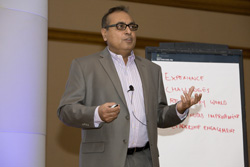 |
| Aseem Bansal explains how he has successfully implemented lean initiatives in the health care industry at the AME Chicago 2012 International Excellence Inside Conference. |
Embarking on the journey to lean is a challenging process that is not accomplished overnight. But with the right driver and the right set of tools, organizations can maximize their efficiency. Aseem Bansal is such a driver and has helped transform several companies in the medical industry. Bansal recently shared his roadmap to AME members at the AME Chicago 2012 International Excellence Inside Conference.
Bansal is vice president of operations at Roche Molecular Diagnostics in New Jersey. He joined the team after Roche acquired Ventana Medical Systems Inc. in 2008. Roche is a Switzerland-based global health care group specializing in pharmaceuticals and diagnostics. Bansal has 18 years of experience implementing lean initiatives within the health care industry, including Ventana in Tucson, AZ, which received the 2007 AME Manufacturing Excellence Award.
Even in the highly technical and regulated world of health care, lean is a winning strategy, Bansal said. In fact, it has become a question of survival as medical companies compete for worldwide markets. This often brings pressure to transform immediately, but Bansal encouraged organizations to fight the temptation to do too much too soon. Lean is a process that is always changing. Once the initial goals are achieved, organizations must continually monitor and train new employees to carry on lean’s success.
At the Chicago conference, Bansal presented a timeline of Ventana’s success:
-
Foundation and Basics (2001-2003)
This first phase of lean introduces the basics to key personnel. It focuses on team structure, production lines, policy deployment and management for daily improvement. -
Build Systems and Metrics (2003-2006)
Here management should expand Kaizen events outside of manufacturing. It should begin educating the customers and get back to basics, as the cultural change process slowly takes shape. -
Cultural Transition (2006-2008)
“You must manage the culture, or it will manage you,” Bansal said. Introducing change to an established culture always is difficult because of strong personalities and basic human nature. -
Sustaining Lean (2009 and forward)
Once lean is established, the work has only begun. Bansal said this is the most difficult of the phases and focuses on talent management. It is a time to engage and recognize existing employees, while continually introducing and training new blood in the organization.
The biggest barriers to change are the team members. Bansal breaks employees down into three categories: change agents, uncertain and “concrete heads.”
Change Agents
In the beginning, change agents represent 25 to 40 percent of the company population. They are the easiest to win over because they are excited to try something new. Bansal said that it should be a goal to grow this population to 90 percent.
Uncertain
Usually more than half of the people involved in the change process will be undecided. Bansal said transforming this group into change agents is the biggest priority.
Concrete Heads
”Concrete heads” pose the biggest challenge. In spite of their unwillingness to change, these people are both smart and influential because they have a track record of success. Usually they resist, but they should not be given up as a lost cause. Once they are convinced, they will become valuable cheerleaders to recruit the uncertain. However, if they continue to resist, the only option is to present the ultimatum — “change or change” by seeking employment elsewhere.
Recruitment
The challenges presented by concrete heads were more prevalent when time came to introduce lean to Roche in 2011. The company was producing more than $1 billion in annual revenue, and many employees argued that there was no need to fix what wasn’t broken. Roche Senior Director of Operations John Baron said the trick was to show employees the results. This includes every employee from the top down.
Roche’s quality control began maintaining billboards to illustrate the achievements. However, Bansal discourages management from setting specific goals because employees might cut corners to get there. Employees also maintain constant awareness through sunrise and sunset meetings. Now employees begin each day discussing company goals and conclude by explaining what went right or wrong.
Celebrate
When things go right, the sunset meetings provide opportunities to publicly recognize the employees responsible. Baron said this helps build morale and is more effective than merely congratulating them on the sidelines. “People like to feel important,” he said.
Bansal said not to stop there. A variety of rewards will help maximize effectiveness. A pat on the back is good, but people also respond to monetary rewards or more formal awards. Mixing up the positive reinforcement will have a more lasting impression. Bansal said he most enjoys “ambush awards.” He recalled one event where select employees were pulled off of the assembly line and taken to the movies where pizza and refreshments were waiting. He added that a Visa gift card is easily forgotten, but everyone will remember Avatar.
These meetings combined with the right group of people help ensure that Roche continues on the right path of its lean journey. However, Bansal reminded his audience that it is sometimes a rocky road with unpredictable turns. Constant attention must be paid to the standard work, and every detail must be measured and broadcast to all employees.


